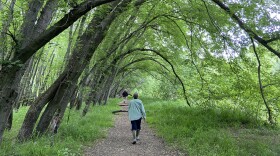Do you have a street in your town named Beech Street or maybe a Beech Hill? You probably don’t give it another thought, but the American beech tree is really special – and they’re now under threat.
So let’s talk about what makes beeches special.
The wide-spreading canopy provides great shade in the summer. Their smooth ash-gray bark persists even as the tree grows into a century-old giant with a spreading canopy. Most trees lose the smooth bark as they grow from saplings, but not the beech tree.
In fact, the beech is associated with wisdom, knowledge, and the written word, because that smooth beech bark was historically used as a writing surface. Even today, folks find it hard to resist carving their initials in the bark.
You’ve definitely seen the leaves, too, although you may not have realized it.
They are oval with pointed tips, and their parallel veins extend to the serrated edge.

They turn a beautiful bronze in the fall. By winter, they have withered to a paler yellow, still hanging on in the understory, adding texture and movement to the austere landscape.
They don’t drop those yellowing leaves until new growth in spring pushes them off. Oaks do this too; it’s called marcescence.
Wildlife, particularly bears and turkeys, appreciate the small triangular nuts, covered in a spiny husk. When beech trees are stressed by drought or insects, the trees produce a lot of seed, almost as a last-ditch effort to perpetuate the species.
Beeches thrive in dense shade and on the very well-drained hillsides of glacial till (the rocky soils compacted by the glacier and smeared like peanut butter across the hills of central New Hampshire), places once cleared for agriculture that then reverted back to northern hardwoods.
Beeches are a huge percentage of the northern hardwood forests. The “holy trinity” of northern hardwood is American beech, Yellow Birch, and Sugar Maple.

In fact, American beech populations across New England have shown a big increase in the last 30 years, thanks to climate change making for higher temperatures and precipitation.
Beech, for all its beauty and appeal, is kind of the “Rodney Dangerfield” of the northern forest. Its timber doesn’t have a ton of value, and deer and bear avoid eating the saplings, preferring to graze on maple or birch.
They are relative newcomers to New England in the pollen record. They arrived some 4,500 years before present, which is 8,000 years post-glaciation and thus later than almost all other familiar species of trees.
Foresters say beech trees are being threatened by Beech Leaf Disease, and it will be a very different forest; we could see as much as 40% of the northern hardwood forest “standing dead” across central New Hampshire as a result.
So take a moment, lean in, and hug an American beech tree! Take a moment to appreciate how important the American beech has been to our state’s forests.
Something Wild is a partnership of NH Audubon, the Forest Society, and NHPR.

Something Wild is a partnership of NH Audubon, the Forest Society, and NHPR.











